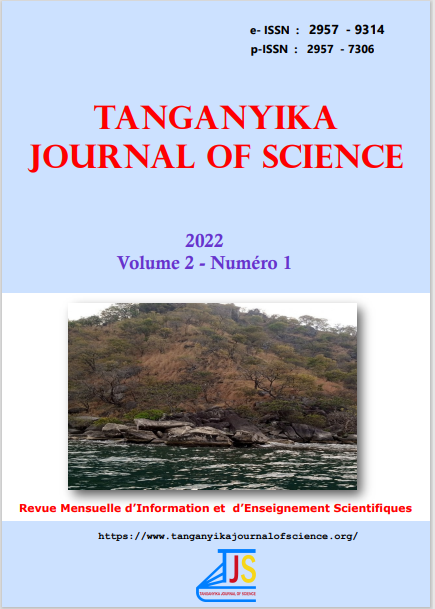PROFILE AND APPRECIATION OF MOTORBIKE TAXI DRIVER JOB (MOTARD) IN KABINDA TOWN, DEMOCRATIC REPUBLIC OF CONGO
DOI:
https://doi.org/10.59296/tjs.v2i1.34Abstract
The demographic growth observed in Africa in the 21st century has exposed the inadequacy of transport infrastructure, which has long been decried. Public transport must nowadays rely on the phenomenon of motorbike taxis. The aim of this study is to determine the characteristics of motorbike taxi drivers and to assess their appreciation of their profession. The study was conducted in the town of Kabinda, Lomami province, in the Democratic Republic of Congo. It was a descriptive and observational study during the period of two months, June and July 2022. The results of this study showed that motorbike taxi drivers (“Motards”) are all male, young and dedicated to their profession. The poor state of the roads, the speed of travel (instead of waiting for the vehicle to fill up), unemployment after studying and the freedom to practice the trade are opportunities that favour the emergence of public transport by motorbike. The majority of motorbike taxi drivers enjoy their job, which is a source of survival for their households. According to our observations, there is an urgent need for the public authorities to take an interest in the short term in the organisation of this profession, and in the long term to improve the state of the roads, to provide urban transport by vehicle and to banish this activity professionally in the public interest.
Downloads
References
Alimo P. K., Rahim A. B. A., Lartey-Young G., Ehebrecht D., Wang L., et Ma W. «Investigating the increasing demand and formal regulation of motorcycle taxis in Ghana », Journal of Transport Geography, 2022; 103: 103398 Doi: 10.1016/j.jtrangeo.2022.103398.
Agossou N. « Les taxis-motos zemijan à Porto-Novo et Cotonou », Autrepart, 2004; 32, 4: 135‑148 Doi: 10.3917/autr.032.0135.
Hu C. et Thill J.-C. « Predicting the Upcoming Services of Vacant Taxis near Fixed Locations Using Taxi Trajectories », International Journal of Geo_Information, 2019;8,7: 95 Doi: 10.3390/ijgi8070295.
Hemchi H. M. « Mototaxis ou clandos entre adaptation citoyenne et refus politique au sein de la ville de N’Djamena », Exposé au CODATUS 2015, Istanbul, Turquie : 1-13
Ehebrecht D., Heinrichs D., et Lenz B. « Motorcycle-taxis in sub-Saharan Africa: Current knowledge, implications for the debate on “informal” transport and research needs », Journal of Transport Geography, 2018; 69: 242‑256 Doi: 10.1016/j.jtrangeo.2018.05.006.
Khonde Mambuene S. « Le succès de la moto comme mode de transport dans le Kongo-Central en R.D.C : ses effets sur la pérennisation de la Réserve de Biosphère de Luki, Patrimoine Mondial de l’Unesco », juin 2021, Consulté le: 21 septembre 2022. [En ligne]. Disponible sur: https://matheo.uliege.be/handle/2268.2/11907
Keutcheu J. « Le « fléau des motos-taxis »: Comment se fabrique un problème public au Cameroun », Cahiers d' Etudes Africaines, 2015; 219: 509‑534 Doi: 10.4000/etudesafricaines.18208.
Mbegu S. et Mjema J. « Poverty Cycle with Motorcycle Taxis (Boda-Boda) Business in Developing Countries: Evidence from Mbeya—Tanzania », Open Access Library, 2019; 6, 8: 1‑11 Doi: 10.4236/oalib.1105617.
Tumwebaze M., Otiam E. O., Rukindo K. M., et Mwesigwa J. « Prevalence and Predisposing Factors of Human Immunodeficiency Virus Infection among the Boda-Boda Riders in Mbarara Municipality-Uganda », Open Journal Of Epidemiology, 2020;10, 3: 235‑250, 2020, Doi: 10.4236/ojepi.2020.103021.
Nicole N. M. O., Jacques E., Léonel A., Wilfried M. E., AbdouM ., Charles B. « Connaissances, Attitudes et Pratiques des Conducteurs de Moto-Taxis de la Ville de Maroua vis-à-vis des Traumatismes Maxillo-Faciaux et leur Prévention: CAP moto-taxis prévention traumatismes maxillo-faciaux », Health Sciences And Disease, 2022; 23, 2: 235-250 Consulté le: 21 septembre 2022. [En ligne]. Disponible sur: http://hsd-fmsb.org/index.php/hsd/article/view/3413
Owona M. L. J., Pouokan D.A., N'na J.-H., Kidwang J.-P., Lompo S.-M., Dieuboue J., et al., « Prévalence et facteurs associés au stress professionnel chez les conducteurs de motos-taxis à Douala, Cameroun », Revue de Médecine et de Pharmacie, 2019; 9, 2: 931-943
Zomalhèto Z., Nayeton Mikponhoué R. C., Wanvoègbe A., Adikpéto I., et Ayélo P. « Prévalence et facteurs associés à la lombalgie chez les conducteurs de taxi moto à Porto-Novo (Bénin) », Pan African Medical Journal;2019; 32: 107 Doi: 10.11604/pamj.2019.32.107.13477.
Cokola C. N. « La création de l’emploi au profit des jeunes désœuvrés et démunis de Kavumu et Miti grâce à l’émergence du transport public entre Kavumu et Bukavu », International Journal of Innovation and Scientific Research, 2017; 33, 2: 240-255
Amougou Mbarga A. B. « Le phénomène des motos-taxis dans la ville de Douala : crise de l’État, identité et régulation sociale: Une approche par les Cultural Studies », Anthropologie et Sociétés, 2010; 34,1: 55‑73 Doi: 10.7202/044196ar.
Kazaura W. G. « A GIS-Based Integrated Model for Exploring Effects of Land Use Changes on Transport Demand: The Case of Dar es Salaam, Tanzania », Current Urban Studies,2019; 7, 3: 459-479 Doi: 10.4236/cus.2019.73023.
Nallet C. « Le défi des mobilités urbaines en Afrique. Le cas du tramway d’Addis-Abeba », Notes de l'Ifri, Février 2018: 38
Oldenburg S. « Agency, social space and conflict-urbanism in eastern Congo », Journal of Eastern African Studies, 2018; 12, 2: 254‑273 Doi: 10.1080/17531055.2018.1452552.
Yin D. « Research on Fuzzy Comprehensive Evaluation of Passenger Satisfaction in Urban Public Transport », Modern Economy, 2018; 9,3: 528‑535 Doi: 10.4236/me.2018.93034.
Obiri-Yeboah A. A., Owusu-Ansah P., Abdul-Aziz A. R., Woangbah S. K., et Asamoah J. N. « Modelling the economic impact of rickshaw transportation in Ghana: The case of kumasi », Results in Engineering, 2022; 15: 1-15 Doi: 10.1016/j.rineng.2022.100517.
Olvera L. D., Plat D., Pochet P., et Maïdadi S. «Motorbike taxis in the “transport crisis” of West and Central African cities», EchoGeo, 2012; 20 [En ligne] Doi: 10.4000/echogeo.13080.
Omokhodion F. Prevalence and risk factors for low back pain within the community in Nigeria. West Africa Journal Of Medicine, 2002 ;21,2 : 87- 90






